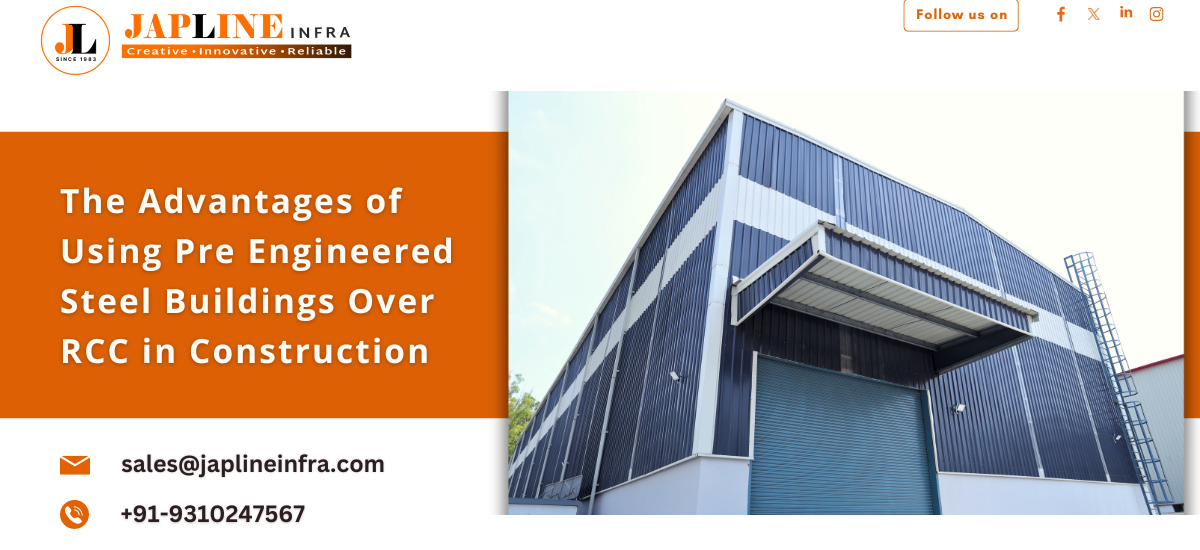The construction industry has seen remarkable advancements over the years, with various building methods evolving to meet the demands of modern architecture and engineering. Among these, Pre Engineered Steel Buildings (PEBs) have gained significant traction, offering a compelling alternative to traditional Reinforced Cement Concrete (RCC) structures. Here’s a closer look at why PEBs are increasingly favoured in construction projects today.
1. Cost Efficiency
One of the primary reasons for choosing PEBs over RCC is cost efficiency. PEB structures are typically more affordable due to their streamlined manufacturing processes. The components of a PEB are fabricated off-site in factories and then assembled on-site, reducing labor costs and minimizing material waste. In contrast, RCC construction involves multiple stages, including formwork, steel reinforcement, and concrete pouring, all of which can be labor-intensive and costly.
2. Speed of Construction
Time is often a critical factor in construction projects, and this is where PEBs excel. Since the components are pre-fabricated, the on-site assembly is quick and straightforward, often taking just a fraction of the time required for RCC construction. This rapid construction process can lead to faster project completion and quicker return on investment, making PEBs an attractive option for developers and builders.
3. Design Flexibility
PEBs offer a high degree of design flexibility. Engineers can customize these buildings to suit specific requirements, whether it’s the size, shape, or functionality of the structure. Modern design software allows for precise customization, ensuring that PEBs can meet complex architectural demands. On the other hand, RCC structures are generally more rigid and less adaptable to changes, particularly if modifications are needed after construction has commenced.
4. Durability and Strength
PEBs are known for their durability and strength. The use of high-quality steel and advanced manufacturing techniques ensures that these buildings can withstand harsh weather conditions and heavy loads. Additionally, PEBs are resistant to corrosion, pests, and fire, making them a reliable choice for long-term use. While RCC structures are also durable, they require regular maintenance, particularly in environments where concrete is prone to cracking or weathering.
5. Sustainability
Sustainability is an increasingly important consideration in construction. PEBs score high on this front due to their efficient use of materials and energy. The precision in fabrication reduces waste, and the steel used in PEBs is often recyclable, contributing to a lower environmental footprint. Moreover, the lighter weight of PEBs means less foundation work is required, which further reduces the environmental impact. In contrast, RCC construction typically involves more material usage and energy consumption, making it less sustainable in comparison.
6. Lower Maintenance
Maintenance is another area where PEBs have a clear advantage. These buildings require minimal upkeep due to the use of rust-resistant materials and protective coatings. This results in lower long-term maintenance costs compared to RCC structures, which can suffer from issues like cracks, spalling, and water seepage that necessitate ongoing repairs.
7. Versatility in Applications
PEBs are versatile and can be used for a wide range of applications, from industrial warehouses and factories to commercial complexes and residential buildings. Their adaptability makes them suitable for various sectors, including agriculture, aviation, and logistics. RCC, while versatile, is often better suited for specific types of construction, such as high-rise buildings or structures requiring significant load-bearing capacity.
Conclusion
In conclusion, Pre Engineered Steel Buildings present a highly efficient, cost-effective, and sustainable alternative to traditional RCC construction. Their speed of assembly, design flexibility, durability, and lower maintenance make them an excellent choice for modern construction projects. As the construction industry continues to evolve, PEBs are likely to play an increasingly prominent role, meeting the demands of the future while addressing the challenges of today.
For more information visit us at www.japlineinfra.com



